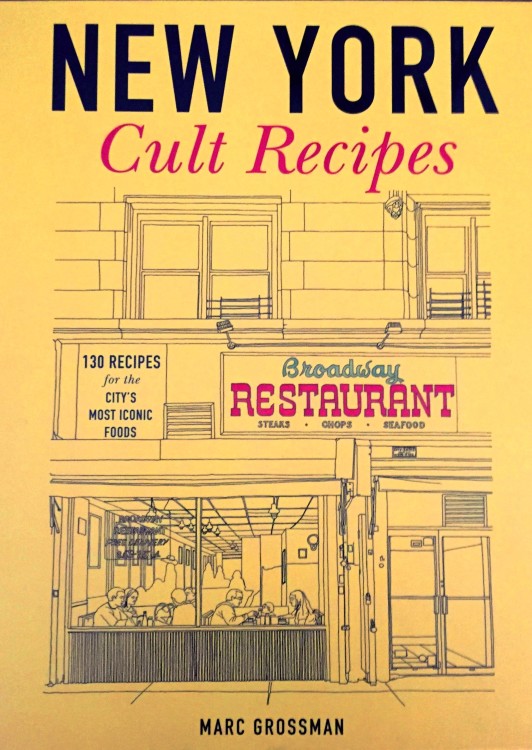
If you grew up in NYC back in the day you will have problems with Marc Grossman’s New York Cult Recipes (2013).
I am being generous in my opening gambit, if nothing more than for the use of “flapjacks.” No New York City native would EVER say “flapjacks,” and it almost delegitimized the whole book for me. It’s PANCAKES. I almost fainted when I saw this. And “Silver Dollar Flapjacks?” Are you kidding me?
First off, the title markets the book one way and the fine print and recipes another. I thought I was buying a book that dealt solely with classic dishes associated with NYC during a certain period, say maybe post-WWII through the 1980s. I have no problem giving plenty of latitude, but a green smoothie and all those cupcakes? A veggie burger?
I certainly would not have jazzed up or updated classic recipes to the extent of a chicken salad with avocado instead of mayo. There are a million other cookbooks out there that take classic recipes to a place that’s more acceptable to current tastes.
Yes, there are numerous recipes for “iconic” NYC dishes, as well as some nice little extras, but there are things the author could have included rather than expending real estate on dishes that make you go “huh?”. Peanut butter smoothie?
The author makes it clear in his intro that these recipes are specific to his unique experience (I am paraphrasing here), which basically takes him off the hook for whatever he wanted to include. No problem, but then convey that in the title.
How about including a knock-off Papaya King drink recipe and Biscuit Tortoni recipe in place of some of those donuts? How about an egg and potato hero — something that screams New York City back in the day? There are many iconic dishes that could have been included rather than those from more recent trends.
Here are a couple nits I need to pick:
His fermented pickles (Slow Pickles) call for distilled water. Many serious fermenters, myself included, would never, ever use distilled water because it’s stripped of everything — including the minerals a ferment needs. Any person wanting to use natural fermentation to make pickles needs to do their research. Seriously. You need to know what you’re doing and make your choice about water (I use spring water) accordingly. Also, standard off-the-shelf pickling spices have no place in NY-style/Kosher-style dill pickles. The author plays fast and loose with spices in his recipe, but if you want the real deal, start with just peppercorns and maybe a few mustard seeds and see how you like that.
More about the pickles. What the author says about half-sours is incorrect. They are not pickled in a full brine and taken out sooner. They are fermented in a weaker brine. Fermenting in a weak brine is potentially hazardous, so it may be safer to approximate a half-sour by his method (I do this sometimes, too), but I have to wonder about the research here. The recipe comes across as all book-work with little hands-on experience.
That said, there are many very nice recipes here. It is just not “130 Recipes for the City’s Most Iconic Foods,” unless you consider a Chocolate Protein Drink classic NYC.
